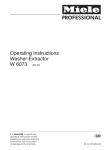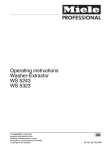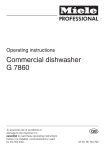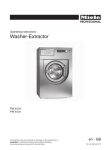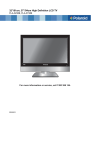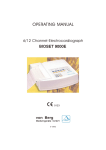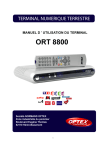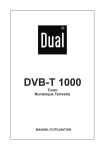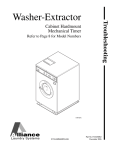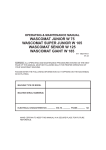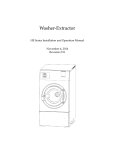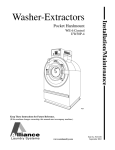Download Miele M 336 EC Operating instructions
Transcript
Operating instructions Washer-Extractor W 6073 (MC 23) To avoid the risk of accidents or damage to the machine it is essential to read these instructions before installing, commissioning and using it for the first time. en - GB M.-Nr. 06 006 842 2 M.-Nr. 06 006 842 Contents Warning and Safety Instructions . . . . . . . . . . . . . . . . . . . . . . . . . . . . . . . . . . . . . . . . . . . . . . . 4 Caring for the environment . . . . . . . . . . . . . . . . . . . . . . . . . . . . . . . . . . . . . . . . . . . . . . . . . . . . 7 Guide to the machine . . . . . . . . . . . . . . . . . . . . . . . . . . . . . . . . . . . . . . . . . . . . . . . . . . . . . . . . . 8 Washing. . . . . . . . . . . . . . . . . . . . . . . . . . . . . . . . . . . . . . . . . . . . . . . . . . . . . . . . . . . . . . . . . . . 12 Before using for the first time . . . . . . . . . . . . . . . . . . . . . . . . . . . . . . . . . . . . . . . . . . . . . . . . . . . 12 Preparing the wash load . . . . . . . . . . . . . . . . . . . . . . . . . . . . . . . . . . . . . . . . . . . . . . . . . . . . . . 12 Programme selection . . . . . . . . . . . . . . . . . . . . . . . . . . . . . . . . . . . . . . . . . . . . . . . . . . . . . . . . . 13 Opening the drum door at the end of the programme. . . . . . . . . . . . . . . . . . . . . . . . . . . . . . . . 14 Dispensing detergent. . . . . . . . . . . . . . . . . . . . . . . . . . . . . . . . . . . . . . . . . . . . . . . . . . . . . . . . 15 Bleaching agents/Fabric conditioner/ Starch . . . . . . . . . . . . . . . . . . . . . . . . . . . . . . . . . . . . . . . . 15 Additional functions. . . . . . . . . . . . . . . . . . . . . . . . . . . . . . . . . . . . . . . . . . . . . . . . . . . . . . . . . 17 Selecting a programme with a coin unit in use . . . . . . . . . . . . . . . . . . . . . . . . . . . . . . . . . . . . . 18 Delay Start . . . . . . . . . . . . . . . . . . . . . . . . . . . . . . . . . . . . . . . . . . . . . . . . . . . . . . . . . . . . . . . . . 18 Programme changes . . . . . . . . . . . . . . . . . . . . . . . . . . . . . . . . . . . . . . . . . . . . . . . . . . . . . . . . 19 Cleaning and Care . . . . . . . . . . . . . . . . . . . . . . . . . . . . . . . . . . . . . . . . . . . . . . . . . . . . . . . . . . 22 Problem solving guide . . . . . . . . . . . . . . . . . . . . . . . . . . . . . . . . . . . . . . . . . . . . . . . . . . . . . . . 25 Opening the drum door in the event of a power failure . . . . . . . . . . . . . . . . . . . . . . . . . . . . . . . 25 Possible reasons for increased levels of foaming . . . . . . . . . . . . . . . . . . . . . . . . . . . . . . . . . . . 27 After sales service . . . . . . . . . . . . . . . . . . . . . . . . . . . . . . . . . . . . . . . . . . . . . . . . . . . . . . . . . . 28 Explanation of symbols on the data plate . . . . . . . . . . . . . . . . . . . . . . . . . . . . . . . . . . . . . . . 29 Notes for the installer. . . . . . . . . . . . . . . . . . . . . . . . . . . . . . . . . . . . . . . . . . . . . . . . . . . . . . . . 30 Transit fittings . . . . . . . . . . . . . . . . . . . . . . . . . . . . . . . . . . . . . . . . . . . . . . . . . . . . . . . . . . . . . . . 30 Connection to water supply . . . . . . . . . . . . . . . . . . . . . . . . . . . . . . . . . . . . . . . . . . . . . . . . . . . . 31 Electrical connection . . . . . . . . . . . . . . . . . . . . . . . . . . . . . . . . . . . . . . . . . . . . . . . . . . . . . . . . . 32 EU Declaration of Conformity . . . . . . . . . . . . . . . . . . . . . . . . . . . . . . . . . . . . . . . . . . . . . . . . . 33 Guarantee . . . . . . . . . . . . . . . . . . . . . . . . . . . . . . . . . . . . . . . . . . . . . . . . . . . . . . . . . . . . . . . . . 35 The washer-extractor must be installed by an approved service technician or an authorised Service Dealer. M.-Nr. 06 006 842 3 Warning and Safety Instructions Technical and electrical safety Please read the operating instructions before using this machine for the first time. They contain important information about the safety, use and maintenance of the machine. This will avoid the risk of accidents and damage to the machine. Appropriate use of the machine This washer extractor is only intended for items of laundry which have not been impregnated with dangerous or inflammable substances. Only machine wash articles which possess a care label stating they are suitable for machine washing. It is the operator’s responsibility to ensure that the standard of disinfection in thermal as well as chemo thermal procedures is maintained (in accordance with § 18 IFSG) by carrying out suitable validation tests. These procedures should be checked on a regular basis, either thermo-electrically using loggers, or bacteriologically with bio indicators. The operator must pay particular attention to maintaining the correct parameters in the procedure, including temperature and with chemo thermal programmes the chemical concentration used. Disinfection programmes must not be interrupted, as this can have a limiting effect on the disinfection result. On no account must solvents of the kind used for dry cleaning be used in this machine. There may be the danger of fire or explosion. Never use or store petrol or petroleum based substances or any easily inflammable substances near the machine. Do not use the machine lid as a resting place. Danger of fire or explosion 4 The electrical safety of this machine can only be guaranteed when continuity is complete between it and an effective earthing system which complies with local and national safety regulations. It is most important that this basic safety requirement is regularly tested by a qualified electrician. The manufacturer cannot be held liable for the consequences of an inadequate earthing system. Do not damage, remove or bypass the safety features and controls on the machine. Where there is any damage to the machine or to the cable insulation the machine must not be used until it has been repaired. Any removable outer panels must be in place, and all moving or electrical parts shielded before the machine is operated. The machine is only completely isolated from the electricity supply either when switched off at the wall isolator, or the mains fuse is withdrawn from the socket. Repairs should only be undertaken by a suitably qualified service engineer to ensure safety. Unauthorised repairs could be dangerous. Faulty components should only be exchanged for Miele original spare parts. Only when these parts are fitted can the safety standards of the machine be guaranteed. The very best materials are used in the manufacture of this machine, and every care is taken in its manufacture. However, with time, deterioration of parts can occur, especially with rubber components such as hoses. Check the inlet hoses regularly for signs of deterioration and replace in good time, to avoid leaks and subsequent damage. M.-Nr. 06 006 842 Warning and Safety Instructions Use of the machine This washer extractor is not intended for use by persons (including children) with reduced physical, sensory or mental capabilities, or lack of experience or knowledge, unless they have been given supervision or instruction concerning its use by a person responsible for their safety. Never allow children to play in, on or near the washer extractor, or to operate it themselves. Please supervise its use by the elderly or infirm. Remember that the door porthole glass can become hot during the operation of the machine. Do not let children touch it. When washing with high temperatures steam can be emitted from the venting slot behind the machine. Do not grip between the suspended drum unit and the seal of the front panel cut-out during spin. Always make sure the drum is stationary before reaching in to remove washing. Reaching into a moving drum is extremely dangerous. Water used for washing and rinsing must not be used as drinking water. It must be discharged into a proper drainage system. The machine should only be operated unsupervised when there is a floor drain (gully) in the direct vicinity of the machine. To avoid flooding: If hooking the hose into a sink make sure that the water can flow away freely to avoid flooding. Secure the hose against slipping. The pressure of the water flowing out can push an unsecured hose out of the sink. M.-Nr. 06 006 842 Disinfecting and cleaning agents often have compounds containing chlorides in them. If these agents dry on to stainless steel surfaces, the residual chlorides will attack the steel and can cause rusting. To protect your machine from rust damage, we recommend only using chloride free disinfecting and cleaning agents for washing and disinfecting programmes and for cleaning stainless steel surfaces of the machine itself. If you are not sure about a particular agent, contact the manufacturer of that agent for advice. If you accidentally spill an agent containing chlorides on the machine it should be rinsed off with water and dried using a soft cloth. Proprietary dyes, dye removers and descaling agents may only be used in this machine if the manufacturer expressly states that they are suitable for use in a washing machine. Follow the instructions on the packaging. Laundry that was soiled with biological oils or fat should be washed using a suitable detergent and/or wash programme. It must also be inspected after washing. If oils or fat are not sufficiently removed they could cause the laundry to self ignite during the drying process. Always follow the instructions of the chemical manufacturer when using a combination of cleaning agents and special application chemicals. Only use such chemicals for the purpose and in the situation specified by the manufacturer in order to avoid the danger of adverse chemical reactions and material damage. If in doubt check the suitability of the product for use in this machine with the manufacturer before using it. 5 Warning and Safety Instructions Where a chemical cleaning agent is recommended on technical application grounds, this does not imply that the manufacturer of the machine takes responsibility for the effect of the chemical on the material of the items being cleaned or on the machine. Please be aware that changes in formulation, storage conditions etc., which may not be publicised by the chemical producer, can have a negative effect on the cleaning result. On no account use pressure washers or hose down the machine to clean it. Use of accessories Accessory parts may only be fitted when expressly approved by Miele. If other parts are used, guarantee, performance and product liability claims may be invalidated. Chlorine and component damage Notes on using chlorine bleach and perchlorethylene Frequent use of chlorine increases the risk of component damage. The use of agents containing chlorine, such as sodium hypochlorite and chlorine bleach in powder form, can damage the protective surface of stainless steel and cause corrosion. Factors affecting this are chlorine concentration levels, contact time and temperature. It is therefore advisable to avoid the use of such agents. Oxygen based bleaching agents should be used instead. If, however, chlorine based bleaching agents have to be used for particular types of soiling, then anti-chlorine measures must also be carried out. If this is not done irreparable damage can occur to components in the machine and to laundry. 6 Anti-chlorine treatment Anti-chlorine treatment has to be carried out immediately after chlorine bleach has been used. Hydrogen peroxide and oxygen based cleaning and bleaching agents must only be used in programmes specified for their use. Any wash performance problems should be discussed with the manufacturer of the cleaning / bleaching product in the first instance. With thiosulfate, especially when used with hard water, gypsum can form, which can lead to incrustations on laundry or deposits in the machine. The exact quantity of additives and the treatment temperatures required must be set and tested on site in accordance with the dosage recommendations of the detergent and additive manufacturers. The laundry must also be tested to make sure it contains no active chlorine residues after processing. Disposal of old machines When disposing of an old washerextractor first make it unusable. Disconnect from all services. Make the door lock inoperative, so that children cannot accidentally shut themselves in. Make appropriate arrangements for the safe disposal of the machine. All personnel working with this machine must be fully trained in all aspects of its use and safety. Keep these instructions in a safe place M.-Nr. 06 006 842 Caring for the environment Disposal of the packing material The transport and protective packing has been selected from materials which are environmentally friendly for disposal and can normally be recycled. Packaging e.g. cling film, polystyrene and plastic wrappings must be kept out of the reach of babies and young children. Danger of suffocation. Rather than just throwing these materials away, please ensure that they are recycled. Disposal of your old machine Electrical and electronic machines often contain materials which, if handled or disposed of incorrectly, could be potentially hazardous to human health and to the environment. They are, however, essential for the correct functioning of your machine. Please do not therefore dispose of it with your household waste. Please dispose of it at your local community waste collection/recycling centre, and ensure that it presents no danger to children while being stored for disposal. It should be unplugged or disconnected from the mains electricity supply by a competent person. M.-Nr. 06 006 842 7 Guide to the machine W 6073 washer extractor with drain valve or drain pump option This machine is constructed in accordance with IEC 60204-1:2005 -Detergent dispenser box -Control panel -Drum door -Front panel -Access flap for suds filter/drainage system and emergency door release 6 -Four adjustable screw feet 1 2 3 4 5 7 8 9 10 11 12 13 14 15 16 17 -Cable entry for extra equipment -Cable entry for dispenser pumps -Cable entry for power supply -Venting socket -Cold water connection -Hot water connection -Openings for dispenser hoses -Drainage hose (for drain pump version) -Back wall -Drainage (for dump valve version) -Air gap (United Kingdom only) Control panel 1 2 3 4 5 1 -Spin speed selector 2 -Temperature and time left display, Delay start 3 -Push button switches 4 -Programme sequence indicator lights 5 -Programme and Temperature selector 8 M.-Nr. 06 006 842 Guide to the machine Push button switches Display h a Door Opens the drum door, releases the "With pre-wash" or "Starch" or "No final spin" buttons, if any of these had been pushed in. +i with Pre-wash Can be selected with programmes A, B, C, E m Starch Can be selected with programmes A, B, E, F min / °C Time display h(rs)/min(s) This display shows how long the wash programme still has to run or with "Delay start" the period of delay. Indicator light m min lights up. or Temperature oC From 20 oC the temperature is shown rising in 5 oC increments. Indicator light p °C lights up. m min Time left w No final spin p °C Temperature Can be selected with programmes A, B, C, D, E, F d Delay start h Start The start of a programme can be delayed up to a maximum of 24 hours. Starts the programme M.-Nr. 06 006 842 9 Guide to the machine Programme sequence indicator lights Programme and Temperature selector On/Start Pre-wash Main wash Rinses Rinses Rinses/Starch Drain Final spin End Water inlet/drain Programmes A Cottons B Minimum iron C Delicates/Synthetics Spin speed (rpm) selector D Woollens E Short programme F Separate Rinse G Separate Spin H Separate Drain Spin speeds of 800, 1000 or 1200 rpm can be chosen for the final spin. Maximum spin speed per programme A Cottons D Wool 1200 rpm. E Short programme G Separate spin B Minimum iron 900 rpm. F Separate rinse C Delicates/Synthetics 10 600 rpm. M.-Nr. 06 006 842 Guide to the machine Detergent dispenser compartments Compartment i - Pre-wash Compartment j - Main wash Compartment x - Liquid bleach Compartment p - Fabric conditioner M.-Nr. 06 006 842 11 Washing Before using for the first time Preparing the wash load The first commissioning of the machine should be carried out only by a Miele service technician or an authorised Miele Service Dealer. It is essential that the machine is installed and connected to power, water and drainage correctly. Flushing out the machine Any residual lubricants and water from testing still in the machine should be flushed out as follows: ^ Do not load any laundry in the machine. ^ Add a little detergent to compartment j. ^ Turn the programme selector switch to the " A Cottons 60°C" programme. ^ Empty all pockets. Foreign objects, (eg nails, coins, paper clips etc) can cause damage to textiles and components in the machine. ^ Press the" h Start" button. Sort the laundry ^ At the end of the proramme turn the programme and temperature selector to the " r End" position. Most garments have a textile care label in the collar or side seam. Sort the laundry by care label symbols. Only wash items in this machine which are stated by the manufacturer to be machine washable on the textile care label. Dark textiles often contain excess dye, and should be washed separately several times before being included in a mixed load. Delicate textiles should be washed separately in a delicates programme. Loading the drum Unfold laundry and load loosely in the drum. For best results make up mixed loads of large and small items. This improves the washing effect and distributes the load better for spinning. Overloading reduces the wash result and causes more creasing. 12 M.-Nr. 06 006 842 Washing Maximum load (weight of dry washing): A Cottons 7.5 kg B Minimum iron 3.0 kg C Delicates/Synthetics 1.5 kg D Woollens 1.5 kg E Short programme 7.5 kg ^ Add detergent for the main wash to compartment j - and if required detergent for the pre-wash to compartment i, fabric conditioner to compartment p and liquid bleach to compartment x . Programme selection ^ Shut the drum door Grasp the door in the open position and slam it shut, (mind your fingers). At first the door may shut with difficulty. This eases in due course. Make sure no items of washing are caught when the door is closed, or they could be damaged. ^ Open the on-site stopcock. ^ Switch on the on-site main switch. ^ Select programme and temperature (e.g. programme A Cottons 95 oC). M.-Nr. 06 006 842 13 Washing Opening the drum door at the end of the programme ? ^ Additionally select pre-wash if required but only with programmes A,B,C,E. Press the "+i with pre-wash" button. After the " r End " indicator lights up: ^ Press the " a Open door" button - the drum door opens. ^ Take out the laundry. Only remove laundry from the machine once the drum has stopped turning, otherwise you may seriously injure yourself. ? ^ Press the " h Start" button. - The indicator light " m min" goes out and the indicator light "p °C" lights up. - The wash programme starts. Temperature display After the programme start the current suds temperature for the main wash is shown in 5 °C increments until the set temperature has been reached. Make sure the drum is empty, otherwise, when the machine is next used items may become damaged (e.g. shrink) or cause other laundry to discolour. If no more laundry is to be done: ^ leave the drum door open. ^ switch the machine off, and switch off at the mains. ^ turn off the stopcock(s). The indicator light " p°C Temperature" lights up. Time display (Time left) Once the temperature set for the main wash has been reached the time left for the programme to run shows in the display in hours and minutes. The " m min time" indicator lights up. The time left counts down in 1 minute intervals. 14 M.-Nr. 06 006 842 Dispensing detergent Water hardness levels Hardness German Hardness Water level in hardness range quality mmol/l level °d I soft 0 – 1.3 0-7 II medium 1.3 – 2.5 7 - 14 III hard 2.5 – 3.8 14 - 21 IV very hard over 3.8 over 21 Bleaching agents/Fabric conditioner/ Starch If you do not know the hardness level of the water in your area you should contact your local water authority for information. Dispensing detergent Add the right amount of detergent as recommended on the packaging. It is important to avoid overdosing as it can lead to excessive foam. Use a low foaming detergent. Bleaching agents Too little detergent results in the following: Only use bleaching agents on textiles with the symbol x on the care label. Liquid bleaching agents must only be added to the compartment marked x. The agent will then be dispensed automatically during the 2nd rinse (cold bleaching). Liquid bleaching agents should only be used with coloureds if the textile manufacturer’s care label states that the textile is colour fast and suitable for bleaching. – The laundry will not be properly clean and will in time become grey and hard to touch. For cold bleaching the 4th rinse must be programmed, (see Programmable functions). – Greasy particles cling to the laundry. Fabric conditioner The amount dispensed will depend on the following: – the quantity of laundry – the water hardness level – the level of soiling. – Lime deposits on the heater elements. Too much detergent results in the following: – Excessive foam. Dispense according to the manufacturer’s recommendations: ^ Open the lid of compartment p. – Low level of agitation. ^ Add fabric conditioner, but do not exceed the max. level mark. – Poor washing, rinsing and spin results. ^ Close the compartment lid. The conditioner is automatically dispensed in the last rinse. At the end of the programme a small amount of water remains in the fabric conditioner compartment. M.-Nr. 06 006 842 15 Dispensing detergent Powder and liquid starch ^ Prepare and dispense the starch solution as stated on the packaging. Automatic dispensing of liquid starch ^ Pour the liquid starch into compartment p (do not exceed the marker level). ^ Close the compartment lid. Adding liquid or powder starch by hand ^ Select the programme required and also push in the "Starch m" button. The programme, and the "time left" indicator will pause before the last rinse. The starch "m " indicator light comes on. ^ Add starch formulation to compartment i. ^ Press the "m Starch" button to release it for the programme to continue. "w No final spin" can be selected to keep creasing to a minimum. The water is drained away, and the load can be taken dripping wet from the drum. 16 M.-Nr. 06 006 842 Additional functions By pressing one or more buttons programmes can be adapted to offer additional functions. +i "With pre-wash" For heavily soiled or stained textiles in programmes A,B,C,E. Cancelling a programme Turn the programme selector to " r End". The indicator lights flash through the other programme stages until the " r End" light is reached. m "Starching" To omit a programme stage For freshly washed textiles such as table cloths, napkins, work wear etc., in programmes A,B,E,F. ^ Turn the programme selector to " r End". w "No final spin" Washing which is not to be spun but taken dripping from the machine in programmes A,B,C,D,E,F. As soon as the programme sequence light for the stage at which the programme should continue starts flashing: Turn the selector switch to the appropriate programme within 3 seconds. To repeat a programme stage Changing programme sequence The programme can be changed at any time where it makes sense. ^ Turn the programme selector to the required programme. The new programme will carry on at the relevant stage. A programme stage must have been finished before it can be repeated: ^ turn the programme selector switch to " r End". When" r End" illuminates in the sequence display: Exceptions: ^ Select the new programe required. If the programme selector has been turned through "r End". ^ Press the " h Start" button. Opting into or out of the following programmes: – F Separate rinse – G Separate spin or – H Separate drain breaks off the programme. The "h Start" button must be pressed in again to start the required programme. ^ After approx. 5 seconds, turn the programme selector switch to " r End" again. As soon as the indicator light of the programme stage to be repeated starts flashing: ^ turn the programme selector switch to the appropriate programme within a period of 3 seconds. When working through a coin unit or coin counter the programme is locked after 3 minutes and no changes are possible. M.-Nr. 06 006 842 17 Additional functions Programmable functions Delay Start It is possible to programme additional functions or change programme sequences. See Programme changes. After the drum door has been shut and a programme chosen the "m min" light flashes as a reminder of the "Delay start" option. Any changes to the standard machine version must be noted on the Programme change chart in this booklet as a record for any subsequent servicing work. This is of particular importance for the service technician, when electronic units may need to be exchanged. With the "d Delay start" button a delay of up to 9 hours 30 minutes can be pre-selected, in 30 minute steps, and beyond this in one-hour steps up to 24 hours. Coin operating mechanism / coin unit Selecting a programme with a coin unit in use ^ Open the on-site stopcock(s). Switch on the on-site mains switch. ^ Select a programme and temperature. m "Starching", w ""No final spin" and d "Delay start" are not available with coin operation. After the delay start time has been set, press the "h Start" button to confirm the command. The time display counts down showing how many hours and minutes it is until the programme starts automatically. "Delay start" can be cancelled before the "h Start" button has been pressed by turning the programme selector to "r End". At the end of the delay period the programme starts and the "m min" indicator light goes out. The "Time min." / "Temperature oC" display shows the water temperature until the drain valve opens at the end of the Main wash. From this moment to the end of the programme the time left is shown. ^ Add detergent and fabric conditioner. ^ Insert coins/tokens. ^ Press the " h Start" button. Coin unit C 5002, C 5003, C 4060 Coins or tokens are "lost" if any of the following are done after the coins have been inserted but before the " h Start" button has been pressed: – the machine door is opened, – the programme selector has been turned past " r End" to another programme. – a programme is interrupted for more than 20 seconds with the coin time counter. Note for the supervisor: Coins and tokens should be emptied on a regular basis to ensure the coin box does not get jammed full. 18 M.-Nr. 06 006 842 Programme changes To change individual programmes by re-programming To access programming mode Programmes can be changed individually to accommodate different wash processes and methods. 20 Programmable functions can be changed with up to 4 Options. The on-site mains switch must be switched on. A previous programme must be completed. ? Before starting: ^ After the drum door is shut the "+i with pre-wash" button must be pressed in and released twice within 4 seconds. The drum door must be open. - A " " (for Programming) will appear in the display after 4 seconds. - The programme sequence indicators "Pre-wash" and "Main wash" flash. All the other buttons must be inoperative, i.e. not pushed in. - Re-programming can be carried out (see example). The programme selector must be at the " r End" position. Spin speed selector can be at any position. M.-Nr. 06 006 842 19 Programme changes Example: Changing the temperature holding time in the main wash The temperature holding time can be changed from 10 minutes to 5 or 15 or 20 minutes. ? 15 minutes is required. Option 3 corresponds to 15 mins.; see Programme Change Chart No.8 / B 95 Temperature holding time in minutes. ^ Press the " a " open door button. ^ Turn the programme selector to B/ 95 oC. " flashes in the display. " - Pressing the " a " open door button saves the change in memory and completes the programming process. ^ Please enter this programming change in the table on the following page. ^ Turn the programme selector to the "r End" position. See the next page for further possible programming changes. ? ^ Press the " h Start" button 3 times. The following appear one after another in the display (10 minutes), (5 minutes), (15 minutes). 20 M.-Nr. 06 006 842 Programme changes No. Programme selector setting Programme function 1 A 95 2 A 80 3 4 5 6 A 70 A 60 A 50 A 40 7 A 30 8 9 10 11 B 95 B 60 B 50 B 40 12 B 30 13 C 60 14 C 40 15 C 30 16 C 20 17 D 40 Additional pre-wash Wash time: (mins) Water level: Pre-wash Select pre-wash Wash times: (mins) Temperature: (°C) Water level: Main wash Thermostop &. Heating active Temp. holding time/mins Water level: Suds cooling: (secs) Temp. in Wool prog. Rinses Increase water level No. of rinse cycles Rinse hold Final spin Pre-spin Special functions Switching over Water inlet 18 D 30 Max. temp. main wash: (°C) 19 D 20 Separate spin free 20 E 3 external disp. pumps Options 2 3 1 Standard no pre-w. low 5 high via button gen/lly yes 8 11 35 45 low high yes no 10 low 25 30 5 high 20 25 no1 3 no 4 Enter programmed option 9 16 60 6 24 15 202 30 slightly1 average1 53 43 yes high 2 no yes* May only be changed by service technician. Sep.rinse Hygiene Cold + Cold Cold, Cold + hot hard hot Cold,soft 90 85 80 yes no comb. 1 comb. 2 comb. 3 comb. 4 1) Load dependent if no. 2,6,9 set to standard setting Chemo thermal disinfection temp. = 60°C 3) With bleach select 4 or 5 rinses. * standard setting 2) M.-Nr. 06 006 842 21 Cleaning and Care Cleaning the washing machine Clean the casing with a mild non-abrasive detergent or soap and water. Wipe dry with a soft cloth. Clean the facia panel with a damp cloth and dry with a soft cloth. The drum and any other stainless steel parts can be cleaned using a proprietary stainless steel cleaner according to the manufacturer’s instructions. ^ Switch the machine off, (either open the door or switch off at the isolator). Do not use any scouring agent or solvent cleaner. If you are unsure about a particular product or need further advice please contact your nearest Miele Sales office. See back page for address. Remove any deposits from the door seal with a damp cloth. ^ Open the drain access flap. ^ Place a 2 litre capacity container underneath the drain fixture. Build-up of rust The drum and suds container are manufactured from rust-free stainless steel. It is, however, possible that water with a high iron content or foreign bodies in the wash, (e.g. paper clips or metal buttons), may lead to the formation of superficial rust spots in the drum and/or suds container, especially if the machine is not used for a long time. Stainless steel components should be cleaned regularly with a proprietary cleaning agent for stainless steel. This must be done if rust appears! Door seals should also be regularly checked to make sure that nothing has got trapped in them. Clean them regularly. Cleaning the drainage system Machine with Drain pump: Check the fluff filter initially after 3-4 washes to ascertain how often it is likely to require cleaning. 22 ^ Turn the fluff filter lid round 2-3 times. Do not take it right out. Approx. 2 litres of water will drain out of the hose. If the drain outlet is clogged, more water will be retained in the machine, (max. 30 l). In this case, screw the fluff filter back into position and empty the container before repeating the procedure as often as necessary. M.-Nr. 06 006 842 Cleaning and Care To clean the filter in the inlet hose: Caution: if laundry has been washed at a high temperature, water draining out of the machine will still be hot. Danger of scalding. ^ Close the stopcock. ^ Once the flow of water ceases, remove the fluff filter completely and clean it. ^ Remove any foreign bodies (e.g. buttons, coins, etc) and fluff. ^ Carefully unscrew the knurled coupling connecting the inlet hose to the stopcock. ^ Remove the rubber seal from the recess. ^ Using pointed pliers, take hold of the plastic filter by the bar, remove the filter and clean it. ^ Turn the impeller by hand to check that it is free to rotate. Any foreign objects causing an obstruction should be removed. ^ Clean inside the fluff filter housing. Remove any deposits of lime scale and detergent or foreign bodies from the thread of the filter housing and filter unit. Screw the fluff filter back into position and close the access panel. ^ Put the filter and seal back in the reverse order. The filters in the inlet hose should be checked and cleaned approx. every 6 months. Because the inlet hose is subjected to high pressure during use, it should be inspected on a regular basis, and replaced if there are small cracks in the surface, or if it has been otherwise damaged. If replacing the inlet hose only use a hose tested to withstand pressure up to 70 bar. Miele’s own hoses meet this requirement. Cleaning the filters in the water inlet The washing machine has the following filters to protect the inlet valves: – in the free end of any water inlet hose, – in the water inlet valve(s) for connecting the hose to the machine. M.-Nr. 06 006 842 23 Cleaning and Care To clean the filter in the water inlet valve: ^ Using pliers, carefully loosen the ribbed plastic nut on the inlet valve, and unscrew. ^ After use the detergent box should be cleaned with warm water to remove any detergent residues. ^ The siphon tubes in compartments § and x should also be cleaned. ^ Unscrew the screws next to the siphons. ^ Use water pump pliers to withdraw the plastic filter by the bar (see illustration). ^ Clean and put back in the reverse order. The machine must not be used without the two dirt filters being put back in place ^ Pull the siphons upwards to remove for cleaning in warm water. Replace in the reverse order, making sure they hook in correctly. The drum should be rotated every 4 weeks to prevent damage to the bearings. If the machine is not going to be used for a longer period of time (4 weeks or more) the drum should be rotated several times after the last use. 24 M.-Nr. 06 006 842 Problem solving guide Dump valve version: Any work on the electrical components of this machine should only be carried out by a suitably qualified and competent person. Unauthorised repairs could be dangerous. ^ Turn the programme selector to " r End". ^ Open the dump valve access flap (see "Cleaning and care)". There are, however, minor faults which can be corrected without contacting the Service Department. Opening the drum door in the event of a power failure Drain pump version: ^ Turn the programme selector to " r End". ^ Open the access flap and drain off any water, (see "Cleaning and Care"). ^ Press the emergency release lever downwards, (see illustration) and hold down until no more water drains out. ^ Press against the drum door and pull on the emergency door opening mechanism (see illustration). Always make sure the drum is stationary before reaching in to remove washing. Reaching into a moving drum is extremely dangerous. M.-Nr. 06 006 842 ^ Press against the drum door and pull on the emergency door opening mechanism (see illustration). 25 Problem solving guide A selected programme does not begin. The "I On/ Start" indicator light does not light up. Check that the door is properly closed, the mains plug is plugged in and that the fuse or circuit breaker has not tripped. The check light " p " flashes, although the programme has finished as usual. The water inlet system is partially blocked: ^ Stopcocks not fully opened. The Pre-wash indicator light " i " is flashing in the sequence display. Start the programme again. If the indicator still flashes call the Service Department. The Main wash indicator light " j " flashes during, or after the end of a programme. If it also flashes during the next programme there is a technical fault. Call the Service Department. ^ Inlet hose kinked or trapped. ^ The water pressure is too low. ^ The filters in the inlet hoses are clogged (see "Cleaning and Care"). The indicator light goes out when the programme selector switch is turned to the " r End" position. Despite adequate water supply pressure, the machine takes a long time to fill. The filters in the water inlet might be blocked. Clean as described under "Cleaning and Care". Large amounts of unused detergent remain in the dispenser. The check light " p " flashes, the " r End", indicator light is on, but the laundry in the machine has not been washed. Water supply pressure is too low. The water inlet system is turned off. ^ Check if the water flow through the stopcock is 5 litres in 15 seconds. ^ Turn the programme selector switch to " r End". ^ Turn on the water supply at the stopcocks. ^ Select a programme. ^ Press the " h Start" button. If little or no water is taken in during the next programme, the water pressure may be too low. If it is adequate there may be a technical fault. In this case, call your local service dealer or the Miele Service Department. ^ Clean the filters (as described in the section "Cleaning and Care"). Washing powder becomes viscous when used together with a water softener. ^ In future pour washing powder into the detergent dispenser before adding water softener. Fabric conditioner or bleaching agent is not completely dispensed or water remains in the dispensing compartment. The siphon is either incorrectly positioned or clogged up. The indicator light " q " is flashing. ^ Lift the lid and remove the siphon. Check whether the drainage system is blocked. ^ Rinse out the dispenser compartment and the siphon with warm water. ^ Clean as described under the section "Cleaning and Care". 26 M.-Nr. 06 006 842 Problem solving guide Possible reasons for increased levels of foaming Laundry is either not spun at all or not spun satisfactorily. – detergent type ^ The " w No final spin" button was pushed in. ^ Only use detergent formulated for use in commercial washer extractors. Domestic laundry detergent is not suitable. – overdosing of detergent ^ Dispense detergent following the detergent manufacturer’s instructions on the packaging and in accordance with local water hardness levels. – detergent creates too much foam ^ Use a lower foaming detergent or contact your detergent application specialist. – very soft water ^ In areas with hardness level 1 dispense less detergent in accordance with the detergent manufacturer’s instructions. – soiling level of the laundry ^ For lightly soiled laundry dispense less detergent in accordance with the detergent manufacturer’s instructions. – residues, e.g. detergent are left on laundry ^ Run an additional pre-wash without detergent and without selecting a temperature. Laundry which has been soaked before washing must be thoroughly rinsed before running a wash programme. – small loads ^ Reduce the amount of detergent dispensed according to the size of the load. ^ The machine was not able to distribute the laundry load evenly. To protect the machine, laundry was either only spun at a reduced speed or not at all. ^ Large items which tangle or roll up in the drum (e.g. bath mats) can cause an imbalance during the spin cycle. For safety reasons, the machine does not spin if this is the case. Attempts to build up spin speed are repeated, however, until the time allocated to spinning has expired. ^ It is therefore important to make up mixed loads consisting of large and small items. ^ The drain system may be clogged. Clean as described in section "Cleaning and Care". The " n " indicator light flashes. The machine has switched off because of serious imbalance. ^ Switch the on-site mains switch off and then on again, or open the drum door with the emergency release as described in "Opening the door in a power cut". The machine shakes during the spin cycle. The most likely cause is that the four machine feet are not resting securely on the floor. ^ Level the machine as described in "Notes for the installer". M.-Nr. 06 006 842 27 After sales service Should a fault occur please contact your nearest authorised Miele Service Department (see back cover for contact details). When contacting Miele, please quote the model type (Typ), the machine number (Fabr.-Nr.) and the part number (M.-Nr.). These can be found on the data plate: With the door open above the door aperture, or: at the rear of the machine towards the top. Only use genuine spare parts. When ordering spare parts, please quote the model type (Typ), machine number (Fabr.-Nr.) and part number (M.-Nr.) of your machine. 28 M.-Nr. 06 006 842 Explanation of symbols on the data plate Machine type Machine number/year of manufacture* Voltage/Frequency Control fusing Drive motor Plate diameter*/Plate quantity* Drum data Drum diameter/drum depth Spin speed Drum volume/Laundry dry weight Kinetic energy Ex. time to top speed Braking time Heating Electric heating Fusing (on site) Steam heating indirect* Steam heating direct* Gas heating* Commissioning date Water registration DVGW-test cert (Water)* 22 Field for CE test symbol.... (Product-ID-No./Gas)* *) not applicable to W 6073 1 2 3 4 5 6 7 8 9 10 11 12 13 14 15 16 17 18 19 20 21 M.-Nr. 06 006 842 Noise emission During wash 58.5 dB During spin 74.3 dB (measured in Germany in accordance with DIN (IEC) 45 635, machine noise regulations 3. GSGV p1. 1.a) 29 Notes for the installer Front transit fitting The washer-extractor must be installed by an approved service technician or an authorised Service Dealer. Installation A concrete floor is the most suitable installation surface. Please note: ^ The machine must be level and securely positioned. ^ Do not install the machine on a ‘soft’ base such as floorboards as this could result in more vibration during the spin cycles. ^ Do not install the machine on carpeted flooring if the carpet pile blocks the ventilation gap at the base of the machine. ^ If the machine is installed on a raised plinth it should be secured using the butt straps supplied with the machine. "A" (1 piece) The front panel must be taken off, (2 internal torx T20 screws at the bottom) to remove the front transit fitting (3 SW-13 screws) . Rear transit fitting If there is not already a concrete plinth on-site, the Miele Spare Parts department offer a steel plinth. Ensure the steel plinth is secured to the floor, (see the enclosed installation plan). To avoid the possibility of frost damage on no account install the machine in a room which is exposed to frost. The machine must not be moved without the outer panels in place. Transit fittings Do not remove the red transit fittings marked "A", "B". and "C" until when the machine has been installed in its final position. The machine must not be moved without the transit fittings in place. The transit fittings should be stored in a safe place for future use. They must be re-fitted if the machine is moved again. 30 "B" (1 piece) "C" (1 piece) The rear panel must be taken off, (just loosen 15 internal torx T20 screws at the bottom) to remove the rear transit fitting (3 SW13 screws each). M.-Nr. 06 006 842 Notes for the installer Levelling The machine must stand level to ensure smooth operation. The adjustable feet can compensate for an uneven base. To ensure the machine is correctly connected please observe the installation plan and the installation instructions supplied with the machine. See the installation diagram supplied for instructions on connection to the water supply and for drainage. The inlet pressure hoses supplied with the machine must be used for connection to the water supply. To ensure the hot water inlet hose (marked 90°C) lasts for many years it is advised not to use it on a hot water connection supplying water hotter than 70°C. ^ Screw the foot or feet out until the machine stands level. ^ Hold the foot tight using a pipe wrench. ^ Tighten the counternut using a screwdriver as indicated. Connection to water supply If replacing an inlet hose only use a hose tested to withstand a burst pressure of at least 70 bar and a temperature of 90°C. This also applies to all connection parts. Miele "Original" spare parts meet this requirement. A water pressure flow rate of at least 1 bar, maximum 10 bar is essential to ensure the smooth operation of this machine. Water taken into the machine must not exceed a temperature of 70°C. Connection to cold water only -See the Installation Plan provided. Connection must be made to the water supply via a stopcock which conforms with local and national regulations. This work must be carried out by a suitably qualified and competent person. Water Supply (Water Fittings) Regulations 1999 and Water Byelaws 2000, Scotland The Type A air gap fitted to the machine provides Category 5 protection thereby enabling connection to mains water. The air gap is located upstream of the detergent box and to provide protection against the possibility of backflow of cleaning agents the machine is supplied with 2 double check valves which should be connected to the inlet hoses. M.-Nr. 06 006 842 31 Notes for the installer Drainage - Machines with a Drain Pump The machine drains via a drain pump with a delivery head of 1 metre. The 1.5 m long drain hose must not be kinked as this restricts drainage. The swivel elbow at the end of the hose can be turned or detached. Drainage possibilities: ^ Direct into a sink: (for the drain pump version). Hook the hose over the edge and secure. Make sure the water can flow away freely to avoid flooding and to prevent water from being sucked back into the machine. ^ Connection to a standpipe. ^ Connection to a plastic drain pipe with a rubber nipple. There is no need for a non-return valve. ^ Drainage via a floor drain (gully). - Machines with a Dump Valve The machine empties through a motor controlled dump valve. A DN 50 angle connector can be used to make connection to an on-site drainage system, (sink box with odour trap). Coin mechanism unit The washer-extractor can be fitted with a coin unit. It can also be connected to an existing coin unit. The correct connection cable is required for this. For the C 4030 / 4031, C 4050 / 4051 and C 4065 / 4070 using timed operation an AD 3 adapter is required. The machine has to be reprogrammed for this connection. This must only be done by a Miele authorised service engineer. Electrical connection All electrical work must be carried out by a suitably competent person in compliance with current national and local regulations. Please take note of the Installation diagram and the Wiring diagram. They are important for electrical connection. This machine is constructed in accordance with IEC 60204-1:2005 and complies with the following electrical standard: IEC 335. The minimum suds level required for activating the heating is given in mm column of water: W 6073 45 mm column of water The voltage and frequency are given on the data plate. The machine must only be connected if these match the mains supply. Variants: 3N 3 3 1 AC 380-415 V 50 Hz AC 220-240 V 50 Hz AC 440 V 60 Hz AC 220-240 V 50 Hz The motor is fitted with an overload protection switch. For extra safety it is advisable to install suitable residual current device. Nominal rated load and fuse rating are given on the data plate. Ensure that these are compatible with the electricity supply. WARNING THIS APPLIANCE MUST BE EARTHED Connection should be made via a suitable isolator with an on-off switch located near the machine which can be used as an emergency off switch. It should be coloured red and yellow for easy identification. When installation and connection have been completed all removable outer panels must be re-fitted before the machine is operated. The coin unit and connection cable are available at extra cost from the Miele Spare Parts Department, or from Miele specialist dealers. 32 M.-Nr. 06 006 842 EU Declaration of Conformity Document No.: 07133940 Month, year: 07.2007 Manufacturer: Miele Company Ltd., KG Address: Industriestrasse 3 D - 31275 Lehrte Product designation: Washer-extractor Model no.: W 6073 Brand: Miele The product listed above complies with the conditions of the following European Directives: EU Directive 2006/42/EG: Machinery directive 89/336/EC: EMC directive European Standard: EN ISO 10472-1 :1997 EN ISO 10472-2 :1997 EN 60204-1 :2006 EN 61770 :1999 + Corrigendum December 2005 + A1 :2004 + A2 :2006 EN 55014–1 :2006 EN 55014–2 :1997 + A1:2001 EN 61000–3–2 :2006 EN 61000–3–3 :2006 Introduction of the CE mark: 2007 Place, date: Lehrte, 10.07.2007 Signed: Construction & Development Management Hr. Dr. Köckerling M.-Nr. 06 006 842 Appliance Production Management Hr. Krimpmann 33 34 M.-Nr. 06 006 842 Guarantee Please contact your Miele Sales Office for details concerning guarantee terms and conditions. See the back cover for contact details. M.-Nr. 06 006 842 35 Alteration rights reserved/2008 M.-Nr. 06 006 842 / 00




































